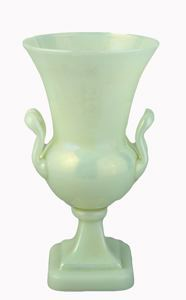
Steuben Glass, inc. (aka Steuben Division of Corning Glass Works)
American, (active 1903–2011)
Frederick Carder
English, (active 1863–1963)
This urn is made from a type of Steuben glass known as Ivrene, developed in the 1920s. The slightly iridescent finish on this translucent, creamy glass was produced by spraying stannous chloride on the piece while the glass was still warm.
The simple shape and sleek profile of this urn is typical of Steuben forms produced during the 1920s when streamlined designs were most popular. The design is classic and free of decoration, thus emphasizing the active outline of the vase and the shapes of which it is comprised. The form is given further interest by the two curving "M" handles on the body of the vase, and the contrast between the straight lines of the base and the curving lines of the body. The continually varying angles of the urn's surface create shifting highlights and reflections which further energize the piece along with the iridescent shimmer of the surface finish.
American, (active 1903–2011)
Frederick Carder
English, (active 1863–1963)
Ivrene Urn
about 1925–1930
Object Type:
Glass
Creation Place:
North America, American, New York
Dimensions:
12 in. x 6 13/16 in. x Diam: 7 1/8 in. (30.48 cm x 17.3 cm x 18.1 cm)
Medium and Support:
Mold-blown glass with pressed glass foot
Accession Number:
1996.0006
Credit Line:
Gift of Neal Brantley in memory of Olive Wiley, by exchange
Currently On View
This urn is made from a type of Steuben glass known as Ivrene, developed in the 1920s. The slightly iridescent finish on this translucent, creamy glass was produced by spraying stannous chloride on the piece while the glass was still warm.
The simple shape and sleek profile of this urn is typical of Steuben forms produced during the 1920s when streamlined designs were most popular. The design is classic and free of decoration, thus emphasizing the active outline of the vase and the shapes of which it is comprised. The form is given further interest by the two curving "M" handles on the body of the vase, and the contrast between the straight lines of the base and the curving lines of the body. The continually varying angles of the urn's surface create shifting highlights and reflections which further energize the piece along with the iridescent shimmer of the surface finish.
Portfolio List
Click a portfolio name to view all the objects in that portfolio
This object is a member of the following portfolios:
Your current search criteria is: Related to "Frederick Carder".

 by Country (2)
by Country (2)
